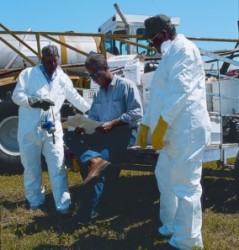For Adjuvants, It’s A New World

Getting the best return for your growers’ herbicide investment gives value to using adjuvants. And now that agriculture is dealing with glyphosate resistance, many different herbicides are being used in a tank mix, and those products may react differently to various adjuvants.
We gathered advice from distributors and other industry experts to help you sort through the choices you’ll need to make.
With rising commodity prices and educated growers realizing the value of crop inputs, it’s changing perception about the value of adjuvant use. “The current commodity prices make it easier for growers to see a positive and more consistent ROI on secondary inputs,” says Jim Reiss, Precision Laboratories vice president of ag chemistries. “Also, I think some growers are starting to sense a moral obligation to maximize food production to ensure some level of security for a growing world population.”
Reiss adds: “As growers and applicators use more multiple-component tank mixes, whether it’s for managing resistant weeds pre or postemergence or enhancing yields with fungicides and foliar nutrition products, there is much more tank mixing.”
More complex decisions mean determining the best way to mesh the proper adjuvants with crop protection inputs. “As the fight against resistant weeds ramps up, and applicators desire to accomplish the multiple objectives of weed control, insect control, plant health and nutrition — in a single application, we’ll see more tank mixing than ever before,” says Reiss.
Tank Mix Concerns
His advice is to beware of the tank mix. “Just because you can add many products to the tank at one time, doesn’t make it a good idea,” he says. “Everything may look like it should mix together, but it won’t without the right technique and mixing sequence.”
According to Reiss, there are two problem areas. “For weed control, it could mean lower levels of performance from the tank mix partner selected to manage resistant weeds,” he says. “Most tank mix partners for glyphosate have significantly different adjuvant needs. In fact, some of the adjuvants used successfully with glyphosate won’t contribute much to optimizing performance of the tank mix partner.”
The second area of concern is greater risk of compatibility problems. “Using the wrong mixing sequencing can cause physical incompatibility and plug sprayer lines, screens and nozzles. Some of these problems take time to clean a sprayer, resulting in lost time and application revenue. If you’re a grower, these delays in weed control may mean lower yields from increased competition,” says Reiss.
Precision Laboratories offers the iPhone and iPad Touch application, which provides proper mixing order for growers using crop protection tank mixes, plus new drift control technology for aerial applicators. Check out the free download on the App Store.
Reiss points out: “Most growers and applicators don’t wake up in the morning thinking that using an adjuvant would make everything better, but maybe they should more than they’ve done in the past. They need to question how adjuvant technology is going to enhance the biological efficacy of the tank mix while protecting the environment and themselves from the risks associated with drift. Hopefully, retailers will welcome these questions and build trust with their customers.”
Terry Nash, manager adjuvant brands for Helena Chemical, says: “From our standpoint, specialty products such as adjuvants, micronutrient and foliar fertilizers have become part of a normal toolbox from burndown to desiccation and everything in between.” A new product Helena is offering in 2012 is Fire-Zone, a unique blend of methylated seed oils and surfactants designed exclusively for burndown.
“When you think about farming, weather has always been the story in most areas. We can’t rely on blanket recommendations. We have sales reps trained to ask the questions needed to help the retailer determine the specific products needed in certain situations, depending on what the grower wants to accomplish,” says Nash. “We also have support staff to help sales reps and retailers being bombarded by numerous situations during the growing season.
“Our goal is to protect every investment the grower makes. Research shows that 70% of the efficacy of the product applied is dependent upon proper application and proper product choice,” he says.
“Retailers and distributors alike should be focused on providing the right recommendations for the proper products in the proper tank mixes at the proper timing.” adds Nash.
The Resistance Issue
Ken Carmack, crop protection area sales manager for MFA Inc., agrees that the critical issue seen in their sales area is more different weed species resistant to glyphosate. “People are struggling with what product to add to get control of resistant weeds,” says Carmack. “Many growers have not sprayed anything except glyphosate for many years, and many of the products we had before are no longer around. We’re in the process of re-educating everyone about what adjuvants do and how they enhance weed control.”
Carmack notes that one lesson learned in 2011 was that foliar nutrition applied with proper timing improves plant health, which in turn leads to higher yields. “Many of our recommendations for 2012 are going to revolve around spraying weeds when they are small and choosing the right adjuvants for the tank mix,” he says. “Retailers need to work with distributors who have agronomic specialists to help in giving the best advice to their growers to aid in choosing the proper surfactants for the weed species and the pesticides.”
There’s no longer a “normal” toolbox when it comes to crop protection, says Carmack. “Our philosophy at MFA is to look at our offering, upgrade when needed and not to make the product line too large,” he says. “This year we will have a full launch on a new product called Torrid.”
Carmack points out that many growers farming large acreages have invested in large spray rigs, but they still need help from their retailer to match adjuvants with pesticides. Many MFA retail stores will be holding spray clinics to discuss growers’ general questions about pesticide application. “Most growers today understand the value of making a relatively small investment in specialty products to protect the value of a large herbicide investment. They are risk adverse.”
Jeff Bunting, GROWMARK crop protection marketing manager, supports a viewpoint similar to other major distributors. He adds: “Drift control to do responsible environmental stewardship is important and that revolves around droplet control with the chemicals sprayed. To do right by your farmers, retailers need to recommend products and practices so the potential for weed control failure is limited.”
Other Considerations
“Retailers are being approached by many companies,” points out Dr. Bryan Young, professor at University of Southern Illinois. “To maintain credibility, retailers should maintain vigor in the products they’re testing and recommending to their valued customers. Let’s not be wasting any money, so be aware that some companies don’t have the research to back up their claims.”
Young suggest that retailers learn the different definitions and categories of adjuvants, noting that more than 600 different adjuvants are in the marketplace. He recommends a pocket guide that may be bound at www.herbicide-adjuvants.com.
“With glyphosate resistant weeds and more tank mixes, adjuvants are relative again,” says Young. “You need to use a methylated seed oil to activate some herbicides, and take into consideration that glyphosate is water-activated.
“Adjuvants really do enhance herbicide performance, especially when using tank mixes to enhance volunteer corn and waterhemp control when using glyphosate,” he says. “It might mean the different between 3% and 80% control.”





